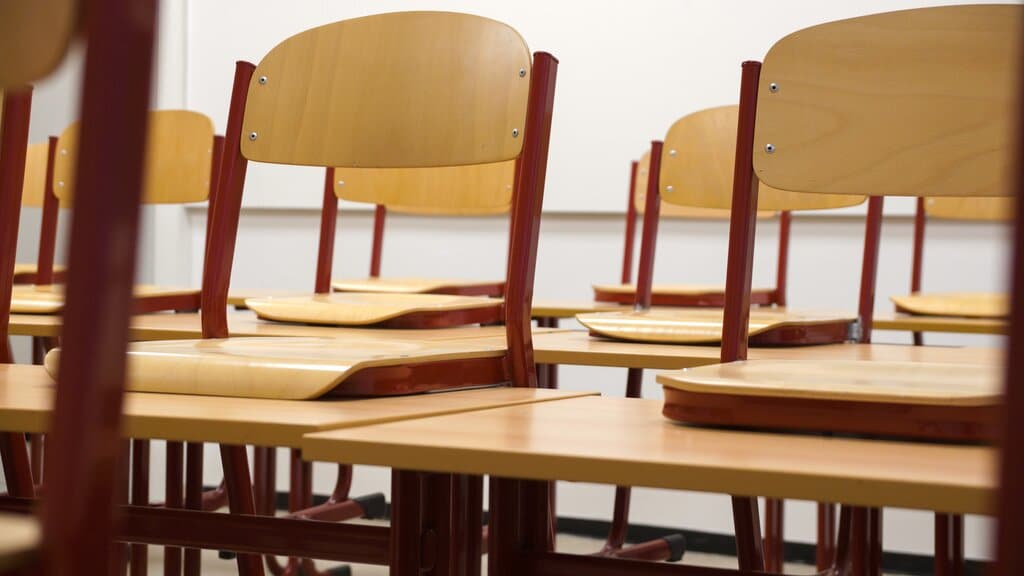Parents want to know they’re sending their kids to a clean, well-maintained school. After all, a clean learning environment is a healthy, productive learning environment for both students and employees. While there’s no way to eliminate every virus or bacteria from any surface, with consistent cleaning procedures, you can ensure a much safer and more hygienic facility.
Read on for your complete guide to how to clean a school properly. Afterward, if you are looking to up your school’s cleaning protocol, reach out to our team at 360clean. We know school budgets are crucial, and we’re always happy to provide you with a free estimate. Now, let’s get down to business.
Why a Clean School Is Important
 Following COVID-19 as students return to in-class lessons, it’s essential that every school—private or public—establishes a comprehensive cleaning protocol. As a team, it is our job to do everything possible to ensure the safety of our teachers, our students, and the families we serve. Not only do we want parents to feel confident about where they’re sending their children, but we also want our teachers to feel good about their school’s environment, too. After all, we couldn’t do it without them.
Following COVID-19 as students return to in-class lessons, it’s essential that every school—private or public—establishes a comprehensive cleaning protocol. As a team, it is our job to do everything possible to ensure the safety of our teachers, our students, and the families we serve. Not only do we want parents to feel confident about where they’re sending their children, but we also want our teachers to feel good about their school’s environment, too. After all, we couldn’t do it without them.
Having a clean and sanitary school benefits you, your students, teachers, families, and staff in so many ways. Here are just a few reasons to think more carefully about your school cleaning protocol:
- Reduce sick absences. Sanitizing surfaces—such as desks and lunch tables—reduces the number of germs that students and faculty come in contact with.
- Improve productivity. Science shows that your physical environment can have a dramatic impact on productivity.
- Improve indoor air quality. Not only does cleaner air reduce allergens and pollutants—thus reducing triggers for asthma and allergies—but it also can help lower your utility bills.
Cleaning vs. Disinfecting
One major aspect of ensuring that your school is being cleaned correctly is understanding the difference between cleaning and disinfecting. Cleaning is usually the first step in disinfecting and sanitizing. The cleaning process removes dirt, germs, and other contaminants from surfaces or objects, typically using water and detergent. This won’t kill germs, but it will reduce the amount present and lower the risk of infection.
Disinfecting involves using EPA-approved chemicals to remove germs from surfaces or objects after cleaning them. It’s another crucial step toward reducing the risk of infection. High-touch surfaces should always be disinfected regularly, often several times each day. These areas include:
- Doorknobs
- Light switches
- Soap dispensers
- Desktops
- Computers
Please note: Some disinfecting solutions can harm electronics, so always read the manufacturer’s labels carefully to determine which disinfecting agents are safe for your school’s computers and other technology.
Safety First
- Safety should be a top priority for anyone cleaning your school. It is best practice to always have Chemical Safety Data Sheets readily available to all school personnel and custodial staff.
- Make sure you also maintain adequate stocks of personal protective equipment (PPE), like masks and glasses, and check your inventory regularly to avoid running out.
How to Clean School Classrooms
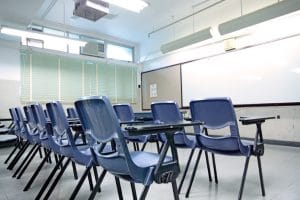 Keeping a classroom clean is an ongoing project. Here’s how to get started:
Keeping a classroom clean is an ongoing project. Here’s how to get started:
- Wipe down all surfaces, including tables, desks, and chairs, with a damp cloth to remove any dirt or smaller debris.
- Use a broom or vacuum cleaner to clean the floors, particularly since dust and dirt get tracked into classrooms daily. A steam mop may help remove tough spots and sterilize surfaces using hot water vapors.
- After cleaning all high-touch surfaces and floors, disinfect them to prevent spreading germs. Follow this routine daily, and your classroom will remain clean and health-friendly all year long.
- Special considerations: Along with desks and chairs, many classrooms have other high-touch surfaces including cubbies and everyday materials, such as markers for the dry erase board. Think carefully about your students’ everyday routine and write down a list of areas that are regularly used. These areas should receive regular attention!
How to Clean School Hallways
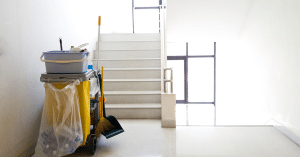 Shiny floors aren’t just for great first impressions — they also last longer and reduce the spread of germs. Dirt and other contaminants often build up in carpets lining school entrances, and studies show that these irritants can trigger asthma and allergies.
Shiny floors aren’t just for great first impressions — they also last longer and reduce the spread of germs. Dirt and other contaminants often build up in carpets lining school entrances, and studies show that these irritants can trigger asthma and allergies.
Carpets should therefore be deep-cleaned regularly, including vacuuming and disinfecting. Use a commercial-grade steamer to remove dirt and debris a minimum of every 6-12 months. Other areas of the hallway that require regular cleaning and disinfecting include:
- Water fountains
- Door knobs and handles
- Door frames and windows
- Lockers and locker handles
- Light switches
- Trash or recycling bins
- Display cases
Things like shelves, clocks, and wall fixtures often go unnoticed, but it’s essential to give them some attention as well. The more dust they collect, the more they contribute to poor indoor air quality. Remember to get your teachers involved, too! Always ask them to remove any work or decorations from outside of their classrooms so you don’t miss a spot.
How to Clean School Restrooms
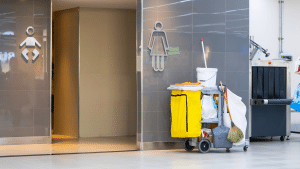 Although cleaning a school restroom isn’t any different from cleaning a normal bathroom, a few additional steps must be completed. Before beginning, you’ll want to make sure you’re equipped with the necessary PPE, including gloves, a facemask, and possibly even eye protection.
Although cleaning a school restroom isn’t any different from cleaning a normal bathroom, a few additional steps must be completed. Before beginning, you’ll want to make sure you’re equipped with the necessary PPE, including gloves, a facemask, and possibly even eye protection.
- Discard trash and debris and clean up biohazards following the usual protocols. After donning your PPE, perform a visual inspection of the area. Look for debris, broken or damaged objects, bodily fluids, or other biohazards that need addressing before you can start cleaning and disinfecting.
- Always replace liners in trash receptacles!
- Disinfect the restroom by spraying an EPA-approved cleaning agent on all sinks, urinals, toilets, and surrounding areas. Remember to lift the toilet seat and spray underneath it to ensure that you’re killing as many germs as possible. Once the chemical has sat for the manufacturer’s recommended time, wipe the surfaces to remove the disinfectant and any residual bacteria.
- Sweep away all tracked in dirt. This is an essential step. You don’t want to spread around dust when it comes time to mop!
- Mop the entirety of the restroom using an EPA-approved cleaning agent.
- Restock! Check the stalls and dispensers to confirm that they’re adequately supplied with hand soap, toilet paper, and paper towels. Double-check battery-operated dispensers and replace any batteries that no longer work.
How to Clean School Faculty Rooms
The faculty room is another area where you’ll find a lot of foot traffic! Remember to include these high-touch surfaces on your disinfection list:
- Door knobs
- Light switches
- Phones
- Tabletops – It’s always wise to keep disposable disinfection wipes here so that teachers and staff can wipe down their area after having lunch.
- Countertops
- Sinks
- Microwaves – Since the microwave is prone to messes (like splattered spaghetti), this is another area where it is wise to keep disposable wipes so that messes can be cleaned as soon as they happen.
- Refrigerators – We recommend having one day a week where teachers are reminded to remove all food and containers (aside from condiments) from the refrigerator. Regularly cleaning and removing these items helps to prevent odors!
- Coffee pots – These pots are often forgotten about throughout the day due to the hustle-and-bustle of school life. It’s smart to have a protocol for how the coffee pot is cleaned throughout the day.
And last but not least, don’t forget these finishing steps!
- Always remember to take out the trash. This should be taken out daily at the least, if not multiple times a day.
- Refill items such as soap, hand sanitizer, and towels. (Important reminder: if you provide coffee, sugar, and cups for your teachers, this is the one thing that you NEVER want to forget!)
- As always, sweep and mop!
How to Clean School Cafeterias
 Aside from the bathrooms, the cafeteria is one of the most challenging areas to clean in the whole school. Cafeterias are full of high-touch surfaces, making them hotspots for bacteria, cold-causing viruses, influenza, and other bad things. Fortunately, using the right tools and equipment and following a specific procedure can make things much easier.
Aside from the bathrooms, the cafeteria is one of the most challenging areas to clean in the whole school. Cafeterias are full of high-touch surfaces, making them hotspots for bacteria, cold-causing viruses, influenza, and other bad things. Fortunately, using the right tools and equipment and following a specific procedure can make things much easier.
1. Always Start with Lunchroom Tables
You always start with cleaning tables and work your way down to the floors. After all, chances are that you’ll be knocking some leftovers onto the floor. You’ll also want to fold tables up afterward and put them aside once they’re sanitized.
Many school cafeteria tables are laminated, which makes them more resistant to wear and tear. Luckily, laminate is also easier to keep clean. Simply wipe tabletops with a combination of warm water and mild detergent. If you’re up against stubborn stains, create a mixture of baking soda and a mild chemical cleaner for more cleaning power. Use a stiff-bristled brush to scrub dried chewing gum, food residue, and other substances from the underside of each table.
2. Sanitize Food Prep Surfaces
Food prep surfaces are notorious for transferring germs and bacteria to students. Your cleaning crew should be equipped with squeegees and absorbent microfiber pads to tackle these difficult areas. Standard sponges are known for simply spreading germs from place to place.
Begin cleaning food prep surfaces by spraying an approved cleaner onto your microfiber cloth and using it to wipe down the countertops. Follow up with a few passes with your squeegee to remove lingering moisture and allow the surface to dry thoroughly.
3. Tackle the Floors Last
Cafeteria floors are often layered with dirt, grime, and bacteria. If possible, use an automated floor scrubber, as these devices can distribute cleaning chemicals more efficiently than mopping. However, mopping is an excellent idea for hard-to-reach places like corners! Dirt can easily accumulate in tiny pockets such as these. Remember, your kitchen floors need equal attention, as well.
How to Clean School Gymnasiums
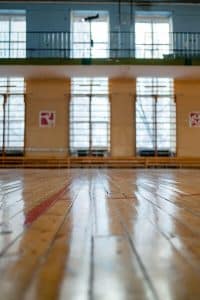 Few parts of the school see the kind of rigorous use that gymnasiums do. Regardless of the type of flooring present, it will accumulate sweat, dirt, and other substances, making it a perfect breeding ground for bacteria and viruses. Keep your gymnasium germ-free by following these steps:
Few parts of the school see the kind of rigorous use that gymnasiums do. Regardless of the type of flooring present, it will accumulate sweat, dirt, and other substances, making it a perfect breeding ground for bacteria and viruses. Keep your gymnasium germ-free by following these steps:
- Sweep the entire floor, piling debris in a corner and disposing of it properly afterward.
- Use a tennis ball to remove shoe smudges and a scraper to pry up gum and other sticky substances.
- Apply an EPA-approved cleaning solution to the floor using a wet mop. If necessary, always remember to sanitize any gym equipment that was used by your class, such as jump ropes or dodge balls.
Cleaning Wrestling Mats
Wrestling mats and similar types of equipment need special attention because they’re often in contact with bare skin, making them a host to many diseases, such as:
- Impetigo
- Ringworm
- Herpes Simplex 1
- Scabies
- Staph Infection/MRSA
You can prevent these diseases from spreading by cleaning mats daily and as needed following large events. Scrub the top side of the mat thoroughly using a damp sponge or cloth. Although not a high-touch surface, the underside of the mat must also be cleaned at least once per week.
While you’re working, don’t forget about the sides and creases of the mats. Although they may be pressed together during activities, they should still be separated, cleaned, disinfected, and dried before they’re put back into storage.
How to Clean Locker Rooms
Locker rooms have a reputation for being bacteria-ridden. Shower stalls are a prime example — it’s crucial to properly clean and disinfect these areas and others. Get in the habit of cleaning your school’s locker rooms daily to guarantee the health and safety of the students who use them. Following these steps will help you ensure that your locker rooms are sufficiently clean:
- Throw away any debris you find on the floor
- Scrub the face, top, and sides of each locker with an EPA-approved disinfectant
- Allow the disinfected lockers to air-dry
- Clean and disinfect toilets, sinks, and showers, paying particular attention to high-touch surfaces like handles and faucets
- Wipe down benches and seats
- Sweep and mop the floors, allowing them to air-dry afterward
How to Clean School Libraries
 Libraries tend to be full of dusty books that absorb and retain moisture. Over time, this can compromise the integrity of the books, damaging them and promoting the growth of mold and mildew. Keeping dust and debris to a minimum in the library will help keep books in optimal condition.
Libraries tend to be full of dusty books that absorb and retain moisture. Over time, this can compromise the integrity of the books, damaging them and promoting the growth of mold and mildew. Keeping dust and debris to a minimum in the library will help keep books in optimal condition.
Dust and vacuum daily to reduce the number of dust particles floating through the air. Students and faculty track all sorts of contaminants through the halls and into the library, so these tasks should be at the top of your list to maintain a clean study environment.
Next, identify the high-touch objects in the room and make sure they’re properly cleaned and disinfected. Such items may include:
- Computers
- Pencil sharpeners
- Tables and chairs
- Door knobs
- Board games and other recreational materials
Use disinfecting wipes or sprays to keep these areas germ-free throughout the year.
School Cleaning Made Simple
We hope you enjoyed this guide on how to clean a school properly! However, if you’re tired of wasting valuable time and resources keeping up with a clean school, you can count on our team at 360clean. We are proud to provide a full-facility school cleaning service to make sure your staff and students stay healthy. Areas we focus on include:
✓ Classrooms
✓ Hallways
✓ Restrooms
✓ Faculty Rooms
✓ Cafeteria
✓ Gymnasium
✓ Locker Rooms
✓ Office Areas
✓ Library
✓ High Traffic Areas & Touch Points
To learn more, contact us today to request a free quote. We can’t wait to help you create a clean and healthy school for you, your team, and your students!

